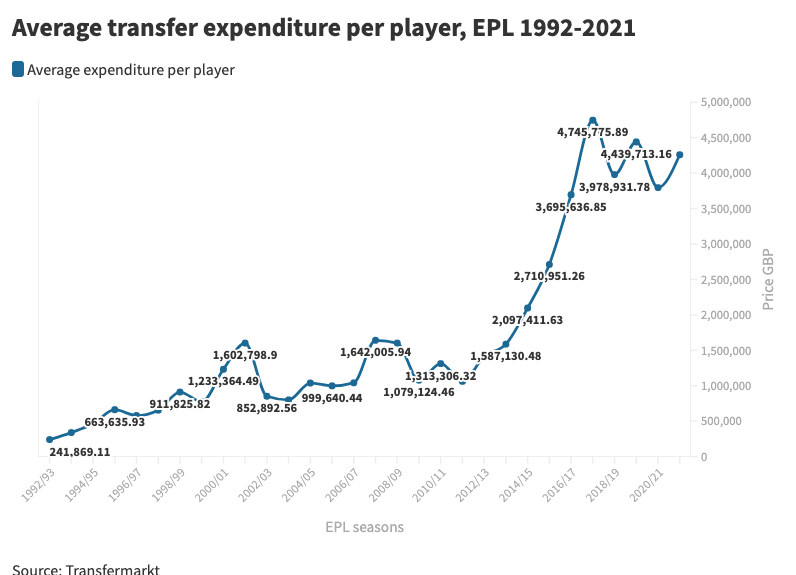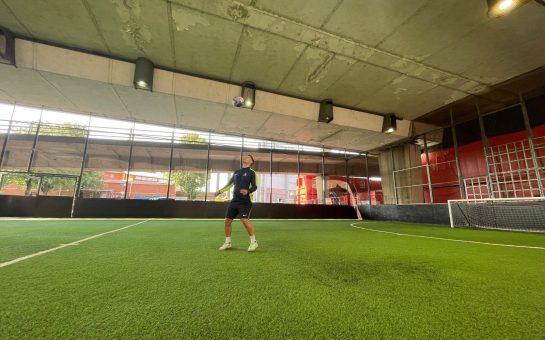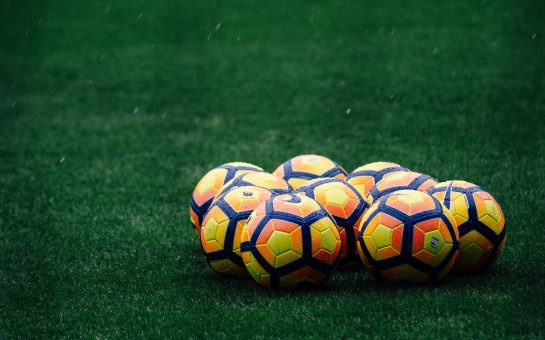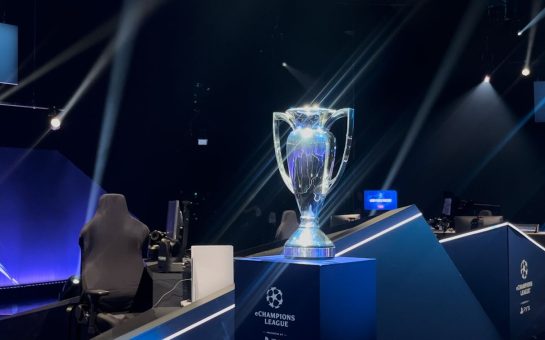If global football star Kylian Mbappe is worth £177 million, and a Greggs sausage roll costs £1.25, how many Greggs sausage rolls is Kylian Mbappe worth?
The answer, of course, is 141.6 million sausage rolls. Quick maths.
Follow-up question: why?
The short answer is supply and demand.
The long answer? That’s where the CIES Football Observatory comes in – a research group within the International Centre for Sports Studies – with a model estimating players’ transfer values across Europe’s big-five leagues.
The model predicts a player’s transfer value based on a set of variables that describe the player’s club (like results and investment), the player himself (like contract duration, age and performance) and the transfer’s inflationary context.
Dr Raffaele Poli, the head of the research group, says that the close correlation between their calculated estimates and the actual sums paid shows that transfer values – which are the costs of players under contract who move from one club to another – are far from irrational.
The latest June 2022 report calculated that Kylian Mbappe is the most valuable player currently, valued at £176.9M. He overtook previous leader Vinicius Junior (£159M), while new Manchester City signing Erling Haaland came in third (£131.4M).
While these transfer values are not record-breaking – they fell during the pandemic – Dr Poli predicts that they will recover and surpass previous levels quickly.
This would match the upward trend in average transfer fees paid over the last two decades – which has fans and pundits worrying about the future of the beautiful game.
In the English Premier League, for example, the average transfer expenditure per player in the inaugural 1992/93 season was £241,869, according to Transfermarkt, a German football information website. By the 2021/22 season, this average was £4,258,462 – over five times as high.
This means that the average transfer expenditure per player has increased between 1992 and 2021, on average, by £131,625 every year.

And this includes the abnormal dip in transfer expenditures during the pandemic in the 2020 season, when, according to CIES, clubs’ lack of income meant transfer indemnities would be negotiated at lower levels than in the past.
But, according to Dr Poli, the football industry is recovering. Player transfer values will soon return to – and surpass – previous levels.
“Around 10 to 15 clubs that are pushing prices up – they are the market drivers,” he explained.
“If five of these clubs have an established squad at the same time and decide against buying new players, inflation for the entire industry considerably slows down.”
With new money coming in from lucrative broadcasting deals and takeovers – the emergence of US owners has seen a significant influx – there are no signs of a slowdown in the race to the top.
According to the CIES, inflation of global transfer prices between 2011 and 2019 stood at a shocking 181 per cent – in the same time period, the pound had a cumulative price increase of around 29.86 per cent. To say football inflation outpaced the pound would be an understatement.
In fact, between 2018 and 2019 alone, there was a +31 per cent inflation in transfer fees, according to the CIES. And while the pandemic slowed the growth of the inflation rate, it did not stop inflation itself.
Good news or bad news?
In the post-Super League “Glazers out” game’s gone era, it is easy to vilify the high transfer fees. But this too is an oversimplification, according to Dr Poli.
It is undeniable that the soaring prices threaten to strangle competition in and across Europe’s big-five leagues.
“The biggest clubs are ready to pay even more money, and the clubs need fresh money because they are financially dependent on the transfer market,” said Dr Poli.
“Then the players also want to leave, because they can earn bigger salaries at the bigger clubs.
“All of these put pressure on independent clubs and push them slowly to accept possible offers from bigger owners owning more clubs,” he explained.
“This reduces the competitive balance, which is an issue not only for the small clubs, but football as an industry – competition becomes more boring,” he explained.
In the English Premier League, this may be reflected in the distribution of points at the end of a season. This has become, on average, increasingly unequal – the gap between the top clubs and the bottom clubs has grown.
Inequality in the distribution of points can be shown with the Gini index, an economic measure for wealth inequality. In a perfectly equal league – where every team ends with the same number of points – this would be zero per cent. In a perfectly unequal league – where one team has all the points and the others have none – the index is 100 per cent.
Between the 1992/93 and 2021/22 seasons, this index jumped from 9.5 to 19.7. The rise in the Gini index is not linear, but the upward tendency is clear – disparity between teams’ points is growing. Increasingly, a small number of top teams finish the league with more points, while more teams at the bottom are left with fewer points.
Simultaneously, the average transfer expenditure per player also increased. And although there is no absolute correlation between the two – one will not necessarily increase every time the other does, and certainly not by a consistent rate – both have grown, on average, over the last 29 seasons in the EPL.
And while correlation is not causation – a cliché for a reason – the correlation is very much there.
Across Europe’s big-five, fans increasingly believe that their leagues have become one- or two-horse races as millions fly around any given transfer window. When winners are decided weeks before the final matchday, the fans sneer – farmers’ league.
But if the high prices kill competition, they also mean clubs stay alive – medium and small ones.
The primary revenue source for super-clubs at the top of the football pyramid is broadcasting rights.
A series of TV deals in 2022 will see the Premier League earn over £10bn over the next three seasons, and this will be split on a 50:25:25 basis – 50 per cent divided equally across the clubs, 25 per cent allocated based on league results and 25 per cent distributed as a facilities fee for televised matches.
The bigger clubs benefit the most.
Meanwhile, a large chunk of medium-sized clubs’ incomes – particularly in the smaller or lower leagues – is made up of transfer revenues.
Arguably, these transfer fees are football’s best redistribution mechanism currently. Money trickles down the pyramid in a chain: from big to medium to small, with within and across leagues.
It is no surprise that the ten clubs with the most positive net balances for transfers are the Lilles, Udineses and Espanyols of the big-five – while the clubs with the most negative net transfer balances are the Manchester Citys, the PSGs and the Barcelonas.
It was even less surprising when smaller clubs panicked in 1999 after FIFA proposed plans to scrap transfer fees and introduce compensation instead, determined by player salary and contract end date.
At the time, vice chairman of Bristol Rovers – a small team that developed young players and sold them for big money – predicted that it would send 50 per vent of League clubs out of business. Others predicted that it would kill off the Football League entirely.
Dr Poli explained the trade-off: “small and medium clubs lose their independency – but perhaps they can win a bit more of stability, because if they do chronically have a deficit every year, then the transfer market is a way to ease the burden and rebalance the sheets.
“The vast majority of clubs depend on the transfer market to balance the sheets,” he said.
“Unless the agents, or even the players, are taking an extortionate amount of money, higher inflation can help them balance the books.”
Which, according to Dr Poli, is the real threat to medium- and small-sized clubs.
If the flow of money is seen as a chain from big to small clubs, agents taking significant cuts is a crack in the chain.
The new American investors have popularised multi-club ownership, where they internalise value chains – they have clubs at every level and can transfer players between their own teams to minimise fees. Another crack.
Loan policies don’t help either – big clubs are now able to buy players on the cheap and can either bring them back without paying fees or flip them for a profit if they are unneeded.
Manchester City just bought Zalan Vancsa from Hungarian outfit MTK, but no one is deluded enough to think that they’ll see the teenager in sky blue next season – or any time soon.
If high transfer fees ensure survival, while these new threats divert money away from redistribution, staggeringly, higher transfer fees may be the solution – with regulation like loan and agent commission caps to ensure the money trickles down.
And if the criticism is that clubs shouldn’t aim to survive, but to thrive – a directive often seen on inspirational wall art in varying shades of rose gold – the point completely misunderstands the industry, says Dr Poli.
“The economic logic of football is not profit maximisation – those who run the club speculate on future incomes, for example,” he said.
“Clubs are not run to last – they are short-term driven.”
And in the short term, clubs care about survival.
At the end of the day, Kylian Mbappe is worth 141.6 million Greggs sausage rolls. It might benefit everyone if he was worth a few more.



